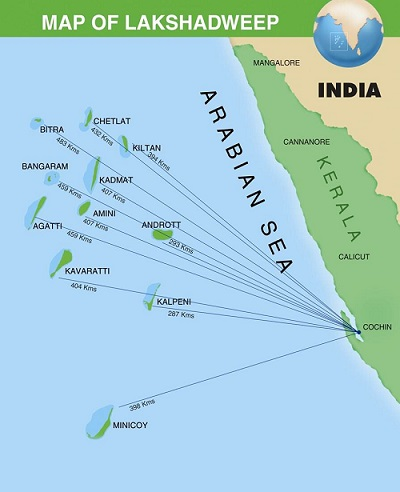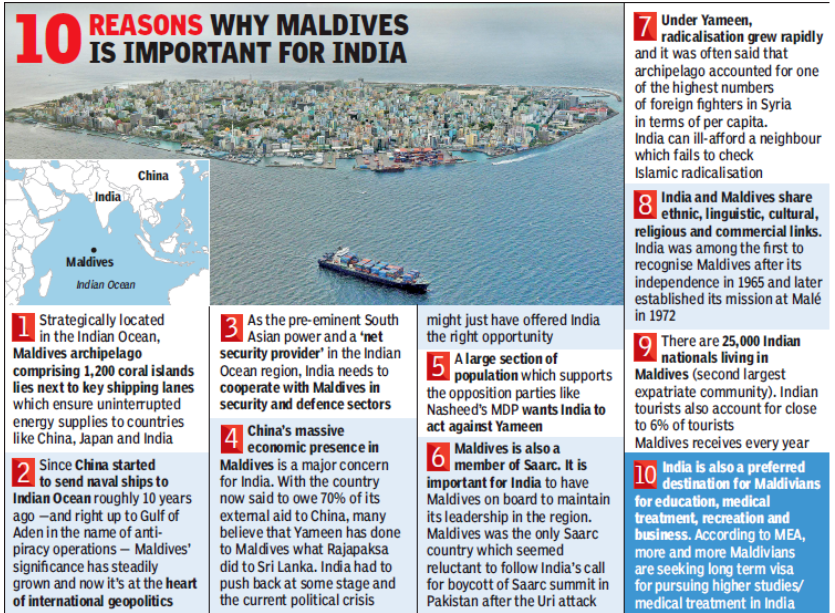International Relations
Vishesh: Lakshadweep
- 15 Feb 2024
- 12 min read
For Prelims: Indian Ocean Region (IOR), Minicoy Island, Buddhism, Tsunamis, Sea Lanes of Communication (SLOCs), Gulf of Aden, Strait of Hormuz, Strait of Malacca, Coral Reefs, Atolls, Exclusive Economic Zones (EEZs), Belt and Road Initiative (BRI), String of the Pearls, Eight Degree Channel, Operation Cactus, Operation Neer, Operation Sanjeevani,
For Mains: Impact of Emerging Tourism in Lakshadweep on Indian Economy.
Why in News?
During a recent visit by the Prime Minister of India to Lakshadweep, a diplomatic dispute arose between India and Maldives when three deputy ministers from Maldives made disrespectful comments.
- The Prime Minister of India was promoting tourism in the Lakshadweep islands.
What are the Important Features regarding India-Maldives Relations?
- Historical Ties:
- The diplomatic and political relationship between India and the Maldives dates back to 1965 when the British relinquished control of the islands.
- India was one of the first countries to recognize Maldives’ independence from British rule in 1965 and to establish diplomatic relations with the country.
- India has helped Maldives in times of crisis, such as the 1988 coup attempt, the 2004 tsunami, and the water crisis in Malé in December 2014.
- These gestures have laid the foundation for the development of trust and enduring, friendly bilateral relations with the Maldives.
- Since the democratic transition in 2008, India has invested years in building deep relationships with various stakeholders in the Maldives, including political, military, business, and civil society figures.
- The diplomatic and political relationship between India and the Maldives dates back to 1965 when the British relinquished control of the islands.
- Significance of Maldives for India:
- The Maldives is a key maritime neighbor of India in the Indian Ocean Region (IOR), located 300 nautical miles from the Indian mainland (West coast) and 70 nautical miles from the Minicoy Island in Lakshadweep.
- The country’s location holds significant strategic importance to India, especially amid China’s growing engagements in the region.
- Maldives-India ties have been mostly cordial over the years, but there was a noticeable tilt towards China during the presidency of the Progressive Party of Maldives (PPM) from 2013 to 2018.
- Cultural Link:
- India and Maldives share a deep cultural and historical connection dating back centuries.
- Until the first half of the 12th century, Buddhism was the principal religion in the Maldivian islands.
- There is an inscription of Vajrayana Buddhism, that had existed in the Maldives in ancient times.
- Regional Stability:
- A stable and prosperous Maldives aligns with India's "Neighbourhood First" policy, promoting peace and security in the Indian Ocean region.
- Significance of India for Maldives:
- Essential Supplies: India is a crucial supplier of everyday essentials, including rice, spices, fruits, vegetables, and medicines.
- Infrastructure: India also aids in building Maldivian infrastructure by providing materials like cement and rock boulders.
- Education: India serves as the primary education provider for Maldivian students who pursue higher education in Indian institutions, including scholarships for deserving students.
- Disaster Assistance: India has been a consistent source of aid during crises, such as tsunamis and drinking water shortages.
- Medical Support: The provision of essential items and support during the Covid-19 pandemic showcases India's role as a reliable partner.
- Defence: Since 1988, defense and security has been a major area of cooperation between India and Maldives.
- India provides the largest number of training opportunities for Maldivian National Defense Force (MNDF), meeting around 70% of their defense training requirements.
- Different Operations in Maldives
- Operation Cactus (1988): Under Operation Cactus the Indian Armed Forces have helped the government of Maldives in the neutralization of the coup attempt.
- Operation Neer (2014): Under Operation Neer India supplied drinking water to Maldives to deal with the drinking water crisis.
- Operation Sanjeevani (2020): India supplied 6.2 tonnes of essential medicines to Maldives, under Operation Sanjeevani as assistance in the fight against Covid 19.
- Greater Male Connectivity Project (2023): India funded and constructed a 6.7 km bridge connecting the capital Male with three other islands, enhancing the connectivity and development of the Maldives.
Maldives
- Maldives, a Toll Gate in the Indian Ocean: Located at the southern and northern parts of this island chain lies the two important sea lanes of communication (SLOCs).
- These SLOCs are critical for maritime trade flow between the Gulf of Aden and Gulf of Hormuz in West Asia and the Strait of Malacca in Southeast Asia.
- Physical geography primarily consists of Coral Reefs and Atolls and most of the area is under Exclusive Economic Zones (EEZs).
- Maldives primarily consists of an archipelago of low lying islands, which has been threatened due to rising sea rise.
- Maldives has massive Chinese investment and became a participant in China's Belt and Road Initiative (BRI). China funded and built various projects in Maldives, including the development of ports, airports, bridges, and other critical infrastructure as part of the “String of the Pearls” initiative.
- Eight Degree Channel separates Indian Minicoy (part of Lakshadweep Islands) from that of Maldives.
Lakshadweep
- About:

- India’s smallest Union Territory, Lakshadweep is an archipelago consisting of 36 islands with an area of 32 sq km.
- It is a uni-district Union Territory and comprises 12 atolls, three reefs, five submerged banks, and ten inhabited islands.
- All Islands are 220 to 440 km away from the coastal city of Kochi in Kerala, in the emerald Arabian Sea.
- It is directly under the control of the Centre through an administrator.
- There are three main group of islands:
- Amindivi Islands
- Laccadive Islands
- Minicoy Island.
- Amindivi Islands are the northernmost while Minicoy island is the southernmost.
- All are tiny islands of coral origin (Atoll) and are surrounded by fringing reefs.
- The Capital is Kavaratti and it is also the principal town of the Union Territory.
- The islands are well connected by regular flights from Kochi. Helicopter transfer is available from Agatti to Kavaratti throughout the year.
- Climate:
- Lakshadweep has a tropical climate and it has an average temperature of 27° C – 32° C.
- April and May are the hottest with an average temperature of 32° C Generally the climate is humid, warm and pleasant.
- As the climate is equitable during monsoons, ship-based tourism is closed.
- October to March is the ideal time to be on the islands.
- From June to October the South West Monsoon is active with an average rainfall of 10-40 mm.
- The relative humidity is 70-75%.
- Annual rainfall decreases from South to North. On an average, 80-90 days a year are rainy.
- Winds are light to moderate from October to March.
- Population:
- More than 93% of the population who are indigenous, are Muslims and majority of them belong to the Shafi School of the Sunni Sect.
- Malayalam is spoken in all the islands except Minicoy where people speak Mahl which is written in Divehi script and is spoken in Maldives.
- The entire indigenous population has been classified as Scheduled Tribes because of their economic and social backwardness. There are no Scheduled Castes in this Union Territory.
- The main occupation of the people is fishing, coconut cultivation and coir twisting. Tourism is an emerging industry.
- Organic Agricultural Area: The entire Lakshadweep group of islands has been declared as an organic agricultural area under the Participatory Guarantee System (PGS) of India.
- Blue Flag Certification: The Blue Flag Certification has been accorded to two new beaches - Minicoy Thundi Beach and Kadmat Beach both in Lakshadweep.
Blue Flag Certification
- It is an internationally recognized eco-label that is accorded based on 33 criterias. These criteria are divided into 4 major heads namely,
- Environmental education and information
- Bathing water quality
- Environmental management
- Conservation and safety services in the beaches
- Blue Flag beaches are considered the cleanest beaches of the world. It is an eco-tourism model endeavoring to provide tourists/beachgoers with clean and hygienic bathing water, facilities, a safe and healthy environment, and sustainable development of the area.
- It is accorded by the international jury composed of eminent members United Nations Environment Programme (UNEP), United Nations World Tourism Organisation (UNWTO), Denmark-based NGO Foundation for Environmental Education (FEE) and International Union for Conservation of Nature (IUCN).
- On the lines of Blue Flag certification, India has also launched its own eco-label BEAMS (Beach Environment & Aesthetics Management Services).
Conclusion
India and the Maldives are old friends who have cooperated in many fields. However, the current situation in the Maldives has harmed the relations. Both sides should talk and find solutions that respect each other’s interests and concerns. They should also avoid any actions that could worsen the situation or invite external interference. By working together, they can ensure a peaceful and prosperous future in the Indian Ocean.
UPSC Civil Services Examination, Previous Year Questions (PYQs)
Prelims
Q. Which one of the following pairs of islands is separated from each other by the ‘Ten Degree Channel’? (2014)
(a) Andaman and Nicobar
(b) Nicobar and Sumatra
(c) Maldives and Lakshadweep
(d) Sumatra and Java
Ans: (a)
Mains:
Q. What do you understand by ‘The String of Pearls’? How does it impact India? Briefly outline the steps taken by India to counter this. (2013)
Q. Discuss the political developments in the Maldives in the last two years. Should they be of any cause for concern to India? (2013)






